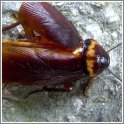Cyborg Insect

Insects perform a number of astonishing tasks like egocentric navigation and decision taking. In this project we aim at exploiting insect intelligence via integration of real brain in a control architecture.
Low level and high level tasks
The difference of performance between a living organism and a conventional robot becomes most apparent in unstructured environments with unknown and potentially hazardous situations occurring in a non-predictable manner. However, unmanned exploratory missions to e.g. Mars or the Moon are in general preferred to missions with human presence since due to several reasons these missions allow to cross boundaries far beyond that where humans can be brought at an acceptable risk. However, facing the challenges of autonomous exploration, the range of future automated mission vehicles strongly correlates with capability of control architecture to successfully integrate a whole range of decision parameters. In this context we investigate the potential of integrating "animal intelligence" into the control architecture of exploratory vehicles. Our aim is to reproduce both low level mechanisms and higher level decision taking behaviours that are necessary for an insect.
The integration of insect intelligence - or the employed mechanisms that lead to emergent intelligence - shall be realized according to their complexity in different manners:
- Elements of short range orientation, such as obstacle avoidance reaction, wall following behaviour, altitude control, etc. were already successfully realized in artificial electronic demonstrators. But the complex decision structures involved in weighing the different inputs from the analogue electronics is still subject to speculation.
- Additionally parameters such as maintaining the energy budget, navigation towards a distant goal, route learning, etc. require a control architecture that obtains a certain flexibility and the ability to autonomously take decisions and revise them: a level of complexity that current control architectures are still far to be successfully managed.
For these high-level tasks we want to examine the potential solution of integrating pre-developed living intelligence, i.e. neuronal circuits taken from the brain of a developed animal.
Consult our publication:
- Benvenuto, A., Sergi, F., Di Pino, G., Campolo, D., Accoto, D., Guglielmelli, E., and Seidl, T., "Conceptualization of an Insect/Machine Hybrid Controller for Space Applications", IEEE BioRob, 2008. (link)